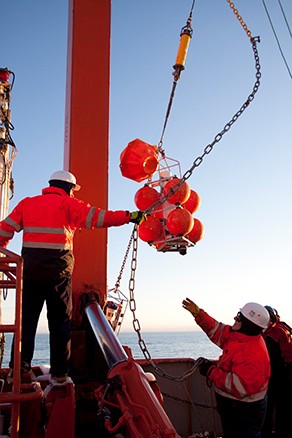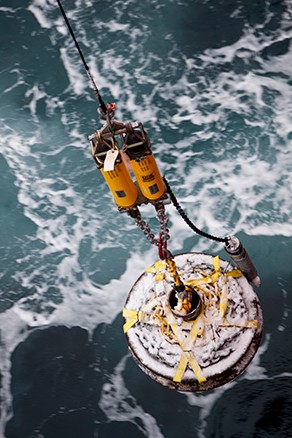The Arctic Ocean is Becoming More Like the Atlantic Ocean

The Arctic Ocean is beginning to take on traits and forces commonly found in the Atlantic Ocean, according to a new study in the 7 April issue of Science.
At one time the Arctic Ocean was covered with substantially more ice and experienced very little mixing of warm and cool layers of water. Yet, the eastern Eurasian Basin of the Arctic is now more ice-free and active, exhibiting the vertical mixing of layers more commonly found in parts of the Atlantic, the study finds.
 Researchers recover data buoy from the Laptev Sea Shelf In 2015. | © Ilona Goszczko
Researchers recover data buoy from the Laptev Sea Shelf In 2015. | © Ilona Goszczko
The changes will have substantial impact on other components of the Arctic Ocean system. For example, it will likely enhance atmosphere-ocean interactions that affect the ocean's heat storage and currents, change freshwater storage and export patterns, alter Arctic ecosystems and possibly change the ocean's response to acidification.
"Our results inform policymakers that the eastern Arctic may be in transition to a very new state," said Polyakov. Over the last decade, the Arctic Ocean has experienced record-breaking losses of sea ice in the summers. The eastern Eurasian Basin, north of Russia, has been nearly ice-free at the end of summer since 2011.
 A Bottom Pressure Recorder Is Deployed in the Eastern Eurasian Arctic Basin In 2013. | © Ilona Goszczko
A Bottom Pressure Recorder Is Deployed in the Eastern Eurasian Arctic Basin In 2013. | © Ilona Goszczko
Since 2002, Igor V. Polyakov of University of Alaska Fairbanks and colleagues have made regular trips to the Arctic Ocean, to deploy and maintain buoy monitoring systems throughout the region. "In the beginning of the program we used powerful Russian icebreakers to reach areas which were traditionally known to have very heavy ice conditions," explained Polyakov. But in more recent years, the powerful icebreakers were no longer needed, he said. "In front of our eyes ice conditions were changing."
The researchers combined data gathered from the buoys between 2002 and 2015 with satellite estimates of ice thickness in this region to better understand changes affecting the Arctic Ocean in recent years.
They found that the eastern part of the Eurasian Basin is evolving into a state with fewer distinct layers defined by changes in temperature and salinity. This leads to fewer barriers to nutrient mixing in the waters, which could drive changes in the local ecosystem. The basin is also characterized by increased vertical mixing and less sea ice. Essentially, the researchers found that deeper warm water is increasingly mixing with the cool layer of water that traditionally lies atop the eastern part of the Arctic Ocean. This has impaired ice formation, even in the winter months.
"In the past, this extensive warmth was well isolated from the surface layers and ice by a fresh cold layer ... Our moorings demonstrated that this layer disappeared in 2013-14 and 2014-15 winters, which has never been observed of the Arctic Ocean before," said Polyakov.
He emphasized the need to better understand the deep ventilation of oceanic heat, in order to improve modeling to reliably predict the future state of the Arctic climate system. Polyakov and his international team, which includes researchers from Russia, Norway and Germany, are planning to expand the monitoring system in the Arctic, called the Arctic Observing Network. They also aim to study the delivery and redistribution of freshwater from the Siberian shelves into the central Arctic Ocean.

